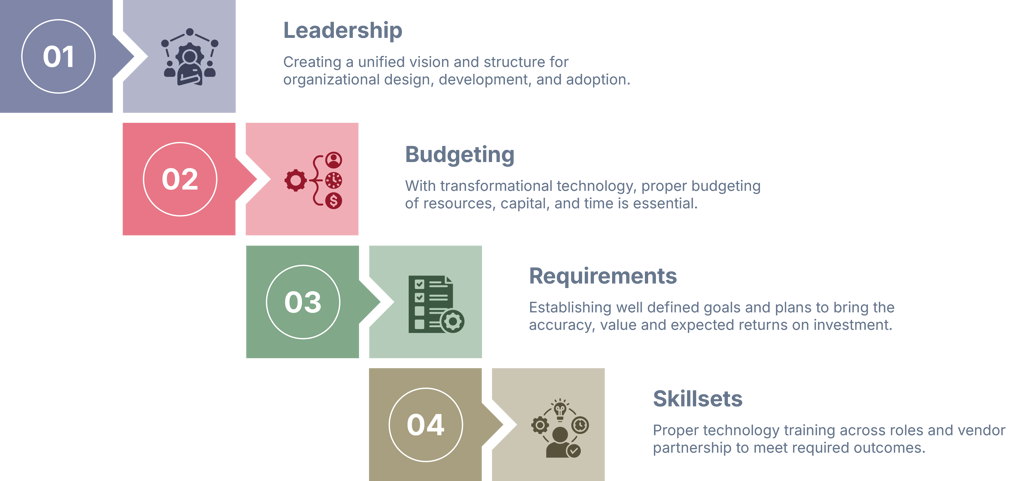GenAI Implementation Obstacles
Lessons learned from early adopter implementations in mobile networks
5 Minute Read
Generative AI in mobile networks represents a transformative leap, offering potential advancements in network optimization, user personalization, and operational efficiency. By integrating AI capabilities into mobile networks, operators can enhance their predictive analytics and automate routine network maintenance tasks, thus promising reduced costs and improved customer experiences. However, despite continued enthusiasm and significant investments in proof-of-concept trials and early-stage implementations, many generative AI projects have encountered stalling points as early adoption implementers. The crux of these failures often lies in common barriers such as inadequate management support, budgetary missteps, requirements planning, data and skill readiness, and mismatched user expectations, prompting a closer examination of where and why these initiatives falter.
Without a clear, strategic vision from organizational leadership, it often results in a directionless approach to generative AI incorporation. When leadership fails to articulate coherent roadmap expectations, the projects lack purpose and direction, leading to fragmented efforts where various teams pursue disparate objectives without aligning them with a broader organizational goal. This ad-hoc implementation diminishes the overall impact of generative AI initiatives and hinders their acceptance and adoption across the organization, creating siloed efforts that fail to achieve their full potential. Without effective strategies, many organizations have struggled to adapt to the technological shifts required for successful, scalable integration. Resistance emerges both within and outside project teams, particularly when established processes or roles are perceived as threatened.
The misaligned financial, time and human resource allocation can derail promising initiatives. Many projects suffer when funds are disproportionately funneled into research and development at the expense of other critical areas or inadequately distributed across various AI-related endeavors, leading to resource bottlenecks. Lower-level managers stalled or extinguished promising ideas within the organization due to resource constraints and pressures to deliver on legacy products that could be avoided with improved strategic planning. Many organizations underestimate the developmental costs and the operational overheads required for maintenance and scalability. Often, the result of not understanding the data readiness for generative AI across their organization from earlier data strategy mistakes. A comprehensive financial plan that accounts for all aspects, including product management and support for adoption and improvement, is critical to avoid costly missteps and ensure adequate funding throughout the program lifecycle.

Projects flounder when objectives are vague or subject to frequent change due to misalignment with business needs. Teams struggle to maintain focus and direction without clear goals, often resulting in disjointed efforts and suboptimal outcomes. Establishing precise objectives from the outset enables more effective planning and execution, fostering a shared understanding of what success looks like and when. Successful integration hinges on alignment with actual business/user team requirements, which in networks includes trust through incredibly high accurancy needs. Disjointed outputs that fail to resonate with core business operations underscore the necessity for stakeholder engagement in the requirement gathering and testing phases, ensuring they are relevant and capable of driving tangible business value.
Resistance from end users can severely impede project success, often rooted in poor user experience or concerns about job displacement. Organizations must employ inclusive design strategies to improve adoption rates that engage users throughout the development process, reassuring them of generative AI's supportive rather than disruptive role in solving their problems. Including adequately considering user needs or expectations. Highlighting the importance of UX/UI design in AI applications ensures that solutions are intuitive and accessible, enhancing user satisfaction and adoption.
Introducing "another" standalone tool that doesn't fully replace existing applications complicates adoption. Balancing tool ecosystem complexity with usability ensures that solutions are pragmatic and effectively integrated into existing workflows without overwhelming users or systems. Integrating generative AI solutions into legacy applications presents challenges, necessitating a delicate balance between innovation and the necessary refactoring or uplifting of outdated technology to ease adoption. Achieving cohesion between new generative AI tools and legacy systems is essential for realizing the full benefits of any implementation.
Lack of adequate knowledge and related training programs can stymie the success of generative AI initiatives. Like many transformational technologies, generative AI demands specialized knowledge and continuous learning efforts to meet evolving user demands and integration complexities. Investing in robust training programs helps bridge this gap and keeps teams updated on the latest advancements and methodologies. A prevalent skills gap can obstruct projects, as employees may lack the necessary expertise for effective collaboration with advanced AI technologies. To overcome this, organizations should develop partnerships with experienced vendors and invest in comprehensive educational programs that elevate internal capabilities.
Generative AI integrations' initial stumbles in mobile networks are often traced to a lack of program planning, organizational leadership, and a misalignment of business requirements. Additionally, challenges in data readiness, user adoption, and skill gaps further complicate these initiatives. Organizations must invest in a clear leadership vision, precise planning and requirement setting, skill development, and thoughtful integration strategies for successful implementation. Learning from successes and failures, mobile network operators can implement a holistic and deliberate approach, unlocking the full potential of generative AI in transforming mobile networks.